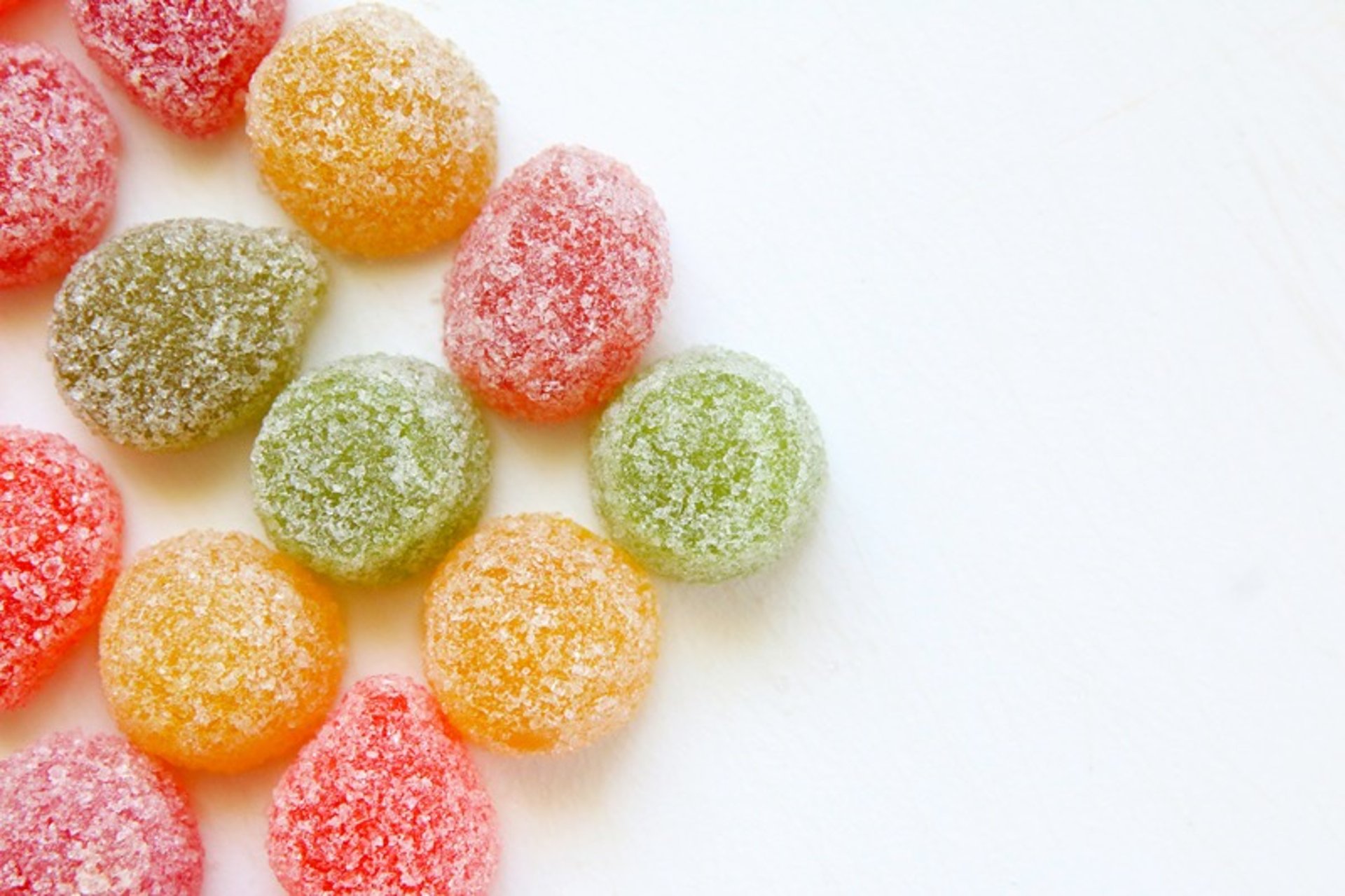
Best Foods for Blood Sugar, Energy & Weight Control
GI vs GL Explained
Smarter Carbs, Better Energy: Understanding GI and GL for Lasting Control
If you’re looking to feel more energized, reduce cravings, manage your weight, or stabilize your blood sugar, the foods you choose can make all the difference. But it’s not just about cutting carbs — it’s about choosing the right ones and knowing how they impact your body.
That’s where Glycemic Index (GI) and Glycemic Load (GL) come into play. These two tools go beyond calorie counts or carb grams. They reveal how fast and how much a food raises your blood sugar — giving you deeper insight into how your meals affect energy levels, hunger, and fat storage.
In this guide, you’ll learn how to use GI and GL to your advantage, discover the best foods for stable energy and weight control, and get practical strategies to build balanced, blood sugar-friendly meals that leave you full, fueled, and focused.
What Is the Glycemic Index (GI)?
The Glycemic Index (GI) is a ranking system that measures how quickly carbohydrates in food are broken down into glucose and absorbed into the bloodstream. It helps us understand how different foods impact our blood sugar levels after eating — an important factor for energy, appetite control, and metabolic health.
Each food is assigned a number on a scale from 0 to 100, based on how much it raises blood glucose compared to pure glucose, which has a GI of 100.
The faster a carbohydrate is digested and absorbed, the higher its GI — and the more likely it is to cause a rapid spike in blood sugar. On the other hand, foods that are digested more slowly lead to a gradual, steady rise in blood glucose, helping you avoid energy crashes and excessive insulin release.

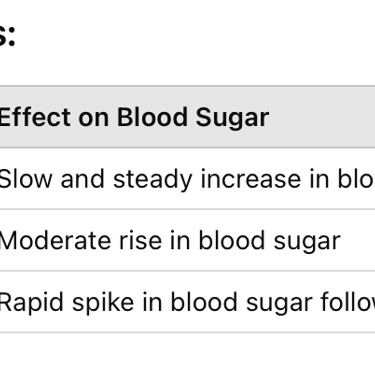
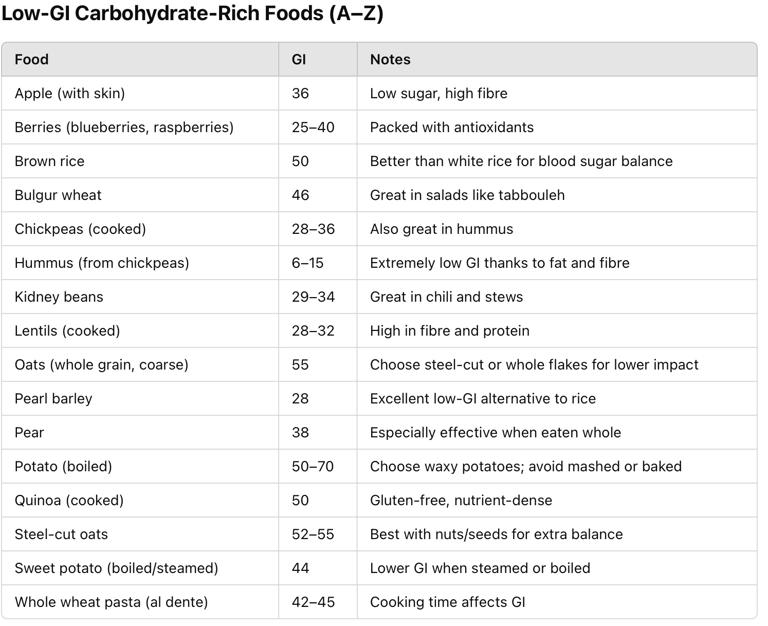

What Is Glycemic Load (GL)?
While GI measures how fast carbs turn into glucose, it doesn’t account for how much carbohydrate is in a serving. That’s where Glycemic Load (GL) comes in. GL provides a more practical picture by factoring in both the quality and quantity of carbohydrates consumed. This makes it especially useful for meal planning, portion control, and understanding the real-life impact of different foods.
GL = (GI × grams of carbs per serving) / 100
Low GL (0–10): Minimal impact on blood sugar; ideal for stable energy and glucose control
Medium GL (11–19): Moderate effect; suitable in controlled portions
High GL (20+): Significant impact; can lead to spikes and crashes if not balanced with other nutrients
Example: Watermelon has a high GI (72), meaning it converts to glucose quickly. However, a typical serving contains very little carbohydrate. Its GL is just around 4 — a minimal effect on blood sugar, despite its high GI.
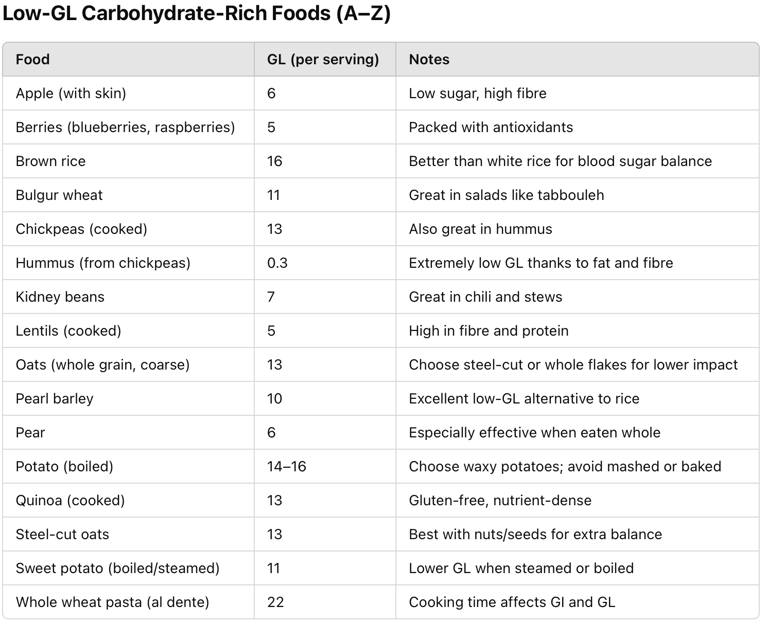

Ideal Meal Composition for Blood Sugar Control
A balanced meal that keeps blood sugar stable typically contains:
Slow-digesting carbs (low GI), such as oats, quinoa, or sweet potato
Adequate protein
Healthy fats
Plenty of fibre from vegetables, legumes, or fruit
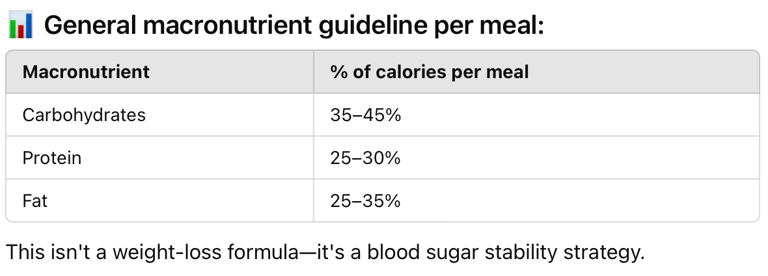

Why this ratio works:
Protein and fats slow down carbohydrate absorption in the digestive system, helping to reduce sudden spikes in blood sugar. This not only promotes steadier glucose levels but also supports longer-lasting satiety.
Fibre further delays digestion and slows the release of glucose into the bloodstream. This effect contributes to a more gradual and controlled blood sugar rise, while also supporting gut health and digestion.
Low-GI carbs are broken down more slowly than high-GI carbs, resulting in a smoother, sustained release of energy rather than a sharp peak followed by a crash. This makes them ideal for consistent energy levels and better appetite regulation throughout the day.
Together, this balanced ratio helps regulate insulin response, reduce cravings, and support a more stable mood and metabolism. It’s particularly helpful for people with insulin resistance, blood sugar fluctuations, or those looking to improve long-term energy and focus.

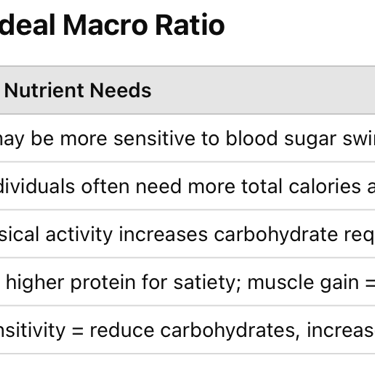
Best Carb-Rich Foods with Low GI and GL
These foods provide energy without spiking blood sugar levels and are excellent for maintaining steady glucose throughout the day. Thanks to their low glycemic impact, they help you avoid energy crashes, mood swings, and excessive insulin spikes. These carbohydrates digest slowly, providing long-lasting fuel for both your body and brain. Whether you’re planning a balanced meal, looking for healthier snack options, or managing your blood sugar for health reasons, the list below offers great choices that support overall metabolic well-being and sustained energy.
By using both GI and GL together, you can better predict how a food will influence your blood sugar — and make smarter, more balanced dietary choice
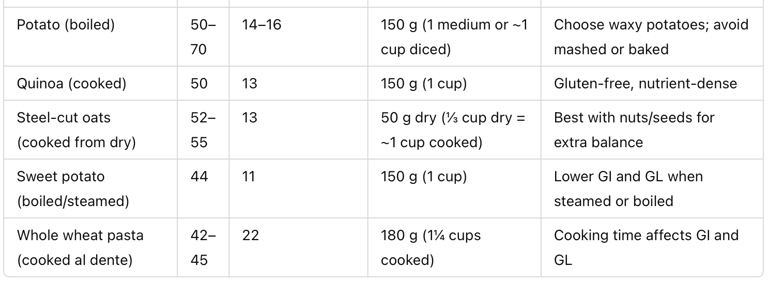

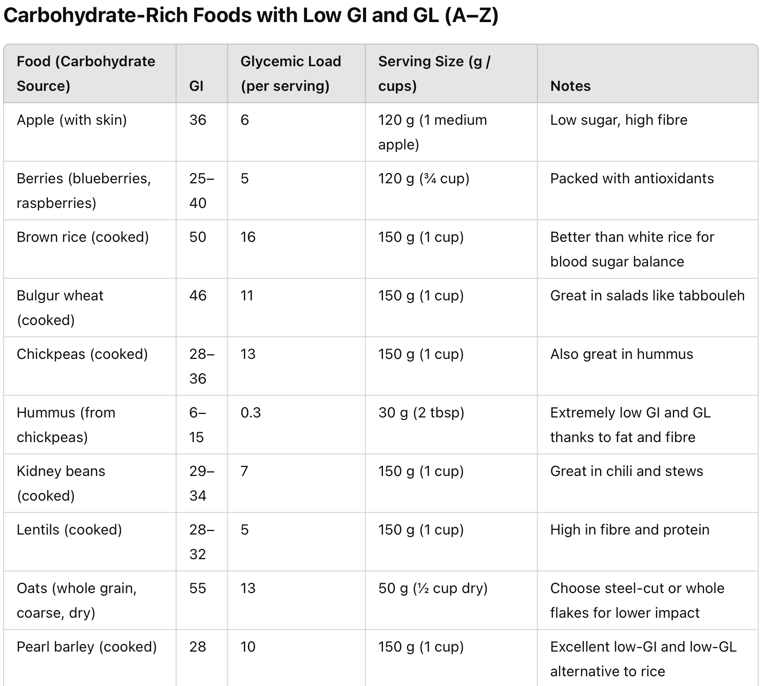

Sample Balanced Meal (approx. 600 kcal):
75g quinoa (slow carb)
120g grilled chicken (protein)
1 tbsp olive oil (healthy fat)
150g steamed broccoli + 50g spinach (fibre)
1 tbsp pumpkin seeds (extra fats & magnesium)

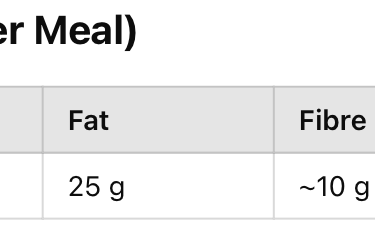
Where to Check GI/GL of Foods Online
Want to check the GI/GL of specific foods? These websites provide trusted information based on nutritional science, food databases, and clinical research. They're helpful whether you're meal planning, managing diabetes, or just curious about how different foods impact blood sugar.
University of Sydney GI Database
This is the gold standard GI resource, developed by the original researchers who pioneered the glycemic index. It offers detailed GI and GL values for hundreds of foods, including common groceries and brand-name items.
Diet-GI.com
Provides easy-to-read GI tables sorted by food category (e.g., fruits, grains, legumes), making it ideal for quick browsing and comparison. Great for beginners.
MyFoodData.com
A broad nutritional database where some foods include GI/GL info alongside macronutrients, vitamins, and minerals. Ideal for people tracking complete nutritional profiles.
You can use these tools to compare foods, plan low-GL meals, and make informed swaps for better blood sugar control.
Final Takeaway
For better blood sugar control, don’t just look at how fast carbs act (GI), but also how much you’re actually eating (GL). Combining both gives you a more complete picture of how different foods affect your body. GI and GL work best when used together to make intentional, informed food choices that fit your goals.
To get the most benefit, aim to pair low-GI, low-GL carbs with sources of healthy fats, lean proteins, and fibre-rich vegetables. This not only slows digestion but helps stabilise your blood sugar, support energy levels, improve mood, and reduce cravings.
It’s also important to remember that everyone is different. What works for one person may not work for another. Your ideal balance of carbohydrates, fats, and protein will depend on factors like your age, body composition, activity level, and personal health goals. There’s no universal rule — just a set of smart tools you can adapt to your own lifestyle.
Understanding GI and GL gives you the power to make more mindful choices and feel more in control of your health.
Want help building a personal blood sugar-friendly meal plan? Just ask!
References
Harvard Health Publishing. Glycemic index and glycemic load for 100+ foods. Harvard Healthmv5.ca
Jenkins, D. J. A., et al. (2002). Glycemic index: overview of implications in health and disease. The American Journal of Clinical Nutrition, 76(1), 266S–273S. PubMed
Augustin, L. S. A., et al. (2015). Glycemic index, glycemic load and glycemic response: An International Scientific Consensus Summit from the International Carbohydrate Quality Consortium (ICQC). Nutrition, Metabolism and Cardiovascular Diseases, 25(9), 795–815. PubMed
American Diabetes Association. Understanding carbohydrates. Diabetes VerenigingPubMed+25Verywell Health+25Verywell Health+25
Brand-Miller, J., et al. (2003). Low-glycemic index diets in the management of diabetes: A meta-analysis of randomized controlled trials. Diabetes Care, 26(8), 2261–2267. diabetesjournals.org
Ludwig, D. S. (2002). The glycemic index: physiological mechanisms relating to obesity, diabetes, and cardiovascular disease. JAMA, 287(18), 2414–2423. JAMA Network
Slavin, J. L. (2005). Dietary fiber and body weight. Nutrition, 21(3), 411–418. PubMed
Atkinson, F. S., Foster-Powell, K., & Brand-Miller, J. C. (2021). International tables of glycemic index and glycemic load values: 2021. Diabetes Care, 44(1), 100–112. PubMed
